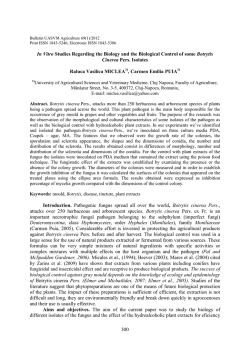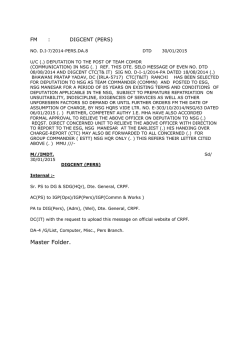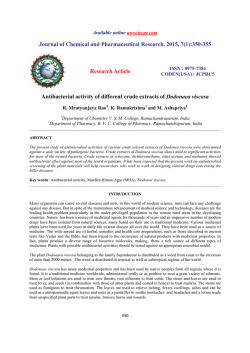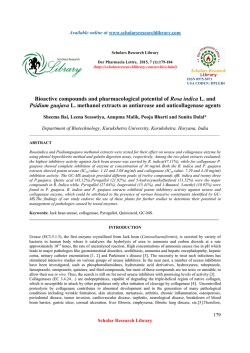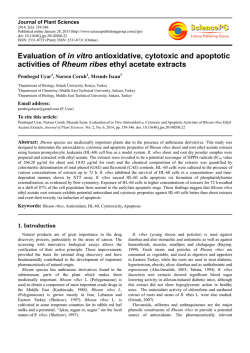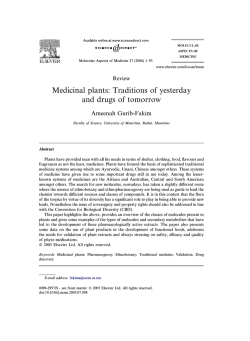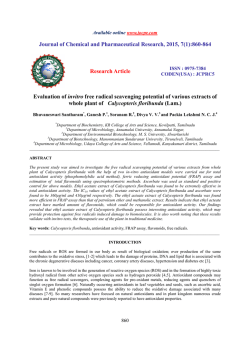
312 Characterization of Botrytis cinerea Pers
Bulletin UASVM Agriculture 69(1)/2012 Print ISSN 1843-5246; Electronic ISSN 1843-5386 Characterization of Botrytis cinerea Pers. Isolates and their Biological Control with Hydroalcoholic Plant Extracts Raluca Vasilica MICLEA, Carmen Emilia PUIA University of Agricultural Sciences and Veterinary Medicine, Cluj Napoca, Faculty of Agriculture, Manastur Street, No. 3-5, 400372, Cluj-Napoca, Romania, E-mail: [email protected] Abstract. Gray mould fungus, Botrytis cinerea is a plant pathogenic fungus with an extensive host range that causes damage to a wide range of crops including vegetables, soft fruit, ornamental plants and grapevines. Control of fungal diseases is a key problem in agriculture worldwide. To develop effective controls for this gray mould, various characteristics of Botrytis cinerea Pers., such as its life cycle and mode of infection, must be determined. Epidemiological studies are difficult because of the genetic and phenotypic variability within this species. Under this consideration the purpose of our study was the observation of the fungus cultural and morphological characteristics but also the testing of the antifungal effect of some plant hydroalcoholic extract. In our experiments we’ve identified and isolated the pathogen Botrytis cinerea Pers., inoculated it on three culture media and we observed the growth rate of the colonies, the sporulation and sclerotia appearance, the shapes and the dimensions of conidia, the number and distribution of the sclerotia. The different extracts in three different concentrations were tested in 80 mm diameter Petri plates incubated at 25ºC and assessed after three, six and nine days of incubation. Plates were examined for the presence or the absence of the colony growth and the diameters of the colonies were measured establishing the colony area and the inhibition percent of the tested plant extracts. Keywords: mould, rot, sclerotia, conidia, tincture, plant extracts Introduction. Gray mould fungus, Botrytis cinerea Pers. is a plant pathogenic fungus with an extensive host range that causes damage to a wide range of crops including vegetables, soft fruit, ornamental plants and grapevines. The pathogen overwinters as mycelium or sclerotia (Elmer and Michailides, 2007). Control of fungal diseases is a key problem in agriculture worldwide. To develop effective controls for this gray mould, various characteristics of Botrytis cinerea Pers., such as its life cycle and mode of infection must be determined (Eksteen et al., 2001). Plant extracts are a very important source of antifungal products and these plant extracts have the potential to develop into effective disease management tools, they have the ability to suppress multiple pathogens (Schilder et al. 2002), are compatible with other products, including synthetic fungicides (Jeandet et al. 1996, Jeandet et al. 2000) and biofungicides and pathogen suppression can range from moderate (Schilder et al. 2002) to high levels, achieved by conventional fungicides (Schmitt et al. 2002). Aims and objectives. Epidemiological studies are difficult because of the genetic and phenotypic variability within Botrytis cinerea Pers specie. Under this consideration the purpose of our study was the observation of cultural and morphological characteristics of the fungus but also the testing of the antifungal effect of some plant hydroalcoholic extract on these isolates of the pathogen. Materials and methods. In our experiments we’ve identified and isolated the pathogen Botrytis cinerea Pers., we’ve inoculated it on three culture media and we observed the growth rate of the colonies, the sporulation and sclerotia appearance, the shapes and the 312 dimensions of conidia, the number and distribution of the sclerotia. We’ve tested different plant extracts (Aloe arborescens, Satureja hortensis, Helleborus purpurascens, Aristolochia clematitis) in three different concentrations (4%, 6%, 8%) which were added to the medium by poison food technique. The centre of each test plate was inoculated with a 1 mm size plug and incubated for 9 days on PDA at 25 ± 2°C. Radial growth was determined by calculating the mean of four perpendicular colony diameters on each replicate and the establishment of the colony area and the inhibition percent of the tested plant extracts compared with control. Analysis of variance (ANOVA) was performed on the data, using the Polifact statistical program to identify differences between treatments. Results and discussions. Our study shows that there were substantial differences in the morphology, the growth rate and the density of sclerotia but only minor differences in the size of the macroconidia. The conidia were ovate, ellipsoidal or sometimes globose to subglobose, smooth, usually unicellular. Conidial dimension had the biggest values on the MA medium in the case of pepper isolate (12.04 – 10.18 µm), on Czapek-agar medium in the case of lettuce isolate (12.78-11.02 µm) and on MA medium for the tomato isolate (12.73-10.09 µm). The sclerotia were black, shinny black or white at first, becoming black with the age. They were variable in shape and size, abundant, rare or absent in others. The number and the distribution of the resistant bodies varied with the type of the media on with the isolate were grown. Thus, the highest number of sclerotia, at 30 days after the inoculation, was obtained in the lettuce isolate’s case, on PDA medium (33 sclerotia) and on MA medium in the tomato isolate (31 sclerotia) and in the case of the pepper isolate (11 sclerotia). The distribution pattern of the sclerotia formation, on the surface of the three culture media was all over the surface of the medium and in the edges of the plates. Regarding the effect of the extracts against Botrytis cinerea Pers. the highest inhibition percentage was obtained in the lettuce isolate’s case with the Helleborus purpurascens and Aristolochia clematitis extracts (100%). The Satureja hortensis extract had also a 100% inhibition on the tomato isolate at all the tested concentrations. Conclusion. Our study shows that there were substantial differences in the morphology, the growth rate and the density of sclerotia but only minor differences in the size of the macroconidia. The fungistatic effects of the extracts indicate the importance of some plant species as a possible natural source of fungicidal material. Antifungal activity was confirmed in all the plants tested, although the results showed that different plant extracts varied in their effectiveness in inhibiting the mycelia growth of the tested pathogen. The development of the Botrytis cinerea Pers. isolates was affected by all the extracts. In all cases the percentage inhibition of the mycelia growth of Botrytis cinerea Pers. was higher in comparison to the untreated control, approximately above 85%. Among the four plant species tested, the Helleborus purpurascens and Aristolochia clematitis extracts were the most effective against the three isolates compared to control. REFERENCES 1. Elmer P. A. G., T. J. Michailides, 2007, Epidemiology of Botrytis cinerea in orchard and wine crops, În Y. Elad et al. (eds.), Botrytis: biology, pathology and control, 243-272. 2. Schilder A, J. Gillet, R. Sysak, J. Wis, 2002, Evaluation of environmentally friendly products for control of fungal diseases of grapes, Proceedings of the 10th International Conference on Cultivation Technique and Phytopathological Problems in Organic Fruit-Growing and Viticulture, Weinsberg, Germany. Weinsburg, Germany: FOKO, p. 163–167. 313 3. Jeandet P., M. Adrian, A.C. Breuil, M. Sbaghi, S. Debord, R. Bessis, L.A. Weston, R. Harmon, 2000, Chemical induction of phytoalexin synthesis in grapevines: application to the control of grey mould in the vineyard, Acta Horticulturae, 528,591–596. 4. Schilder A, J. Gillet, R. Sysak, J. Wis, 2002, Evaluation of environmentally friendly products for control of fungal diseases of grapes, Proceedings of the 10th International Conference on Cultivation Technique and Phytopathological Problems in Organic Fruit-Growing and Viticulture, Weinsberg, Germany. Weinsburg, Germany: FOKO, p. 163–167. 5. Schmitt A., S. Kunz, S. Nandi, B. Seddon, A. Ernst, 2002, Use of Reynoutria sachalinensis plant extracts, clay preparations and Brevibacillus brevis against fungal diseases of grape berries, Proceedings of the 10th International Conference on Cultivation Technique and Phytopathological Problems in Organic Fruit-Growing and Viticulture Weinsberg, Germany, Weinsburg, Germany: FOKO, 146–151. 6. Eksteen D, Pretorius JC, Nieuwoudt TD, Zietsman PC (2001). Mycelial growth inhibition of plant pathogenic fungi by extracts of South African plant species. Annals. Appl. Biol. 139 (2): 243-249. 314
© Copyright 2025
